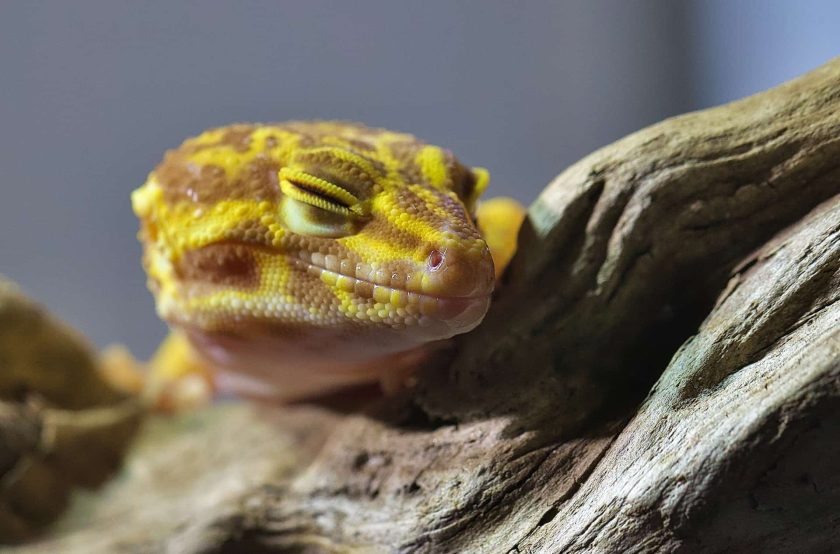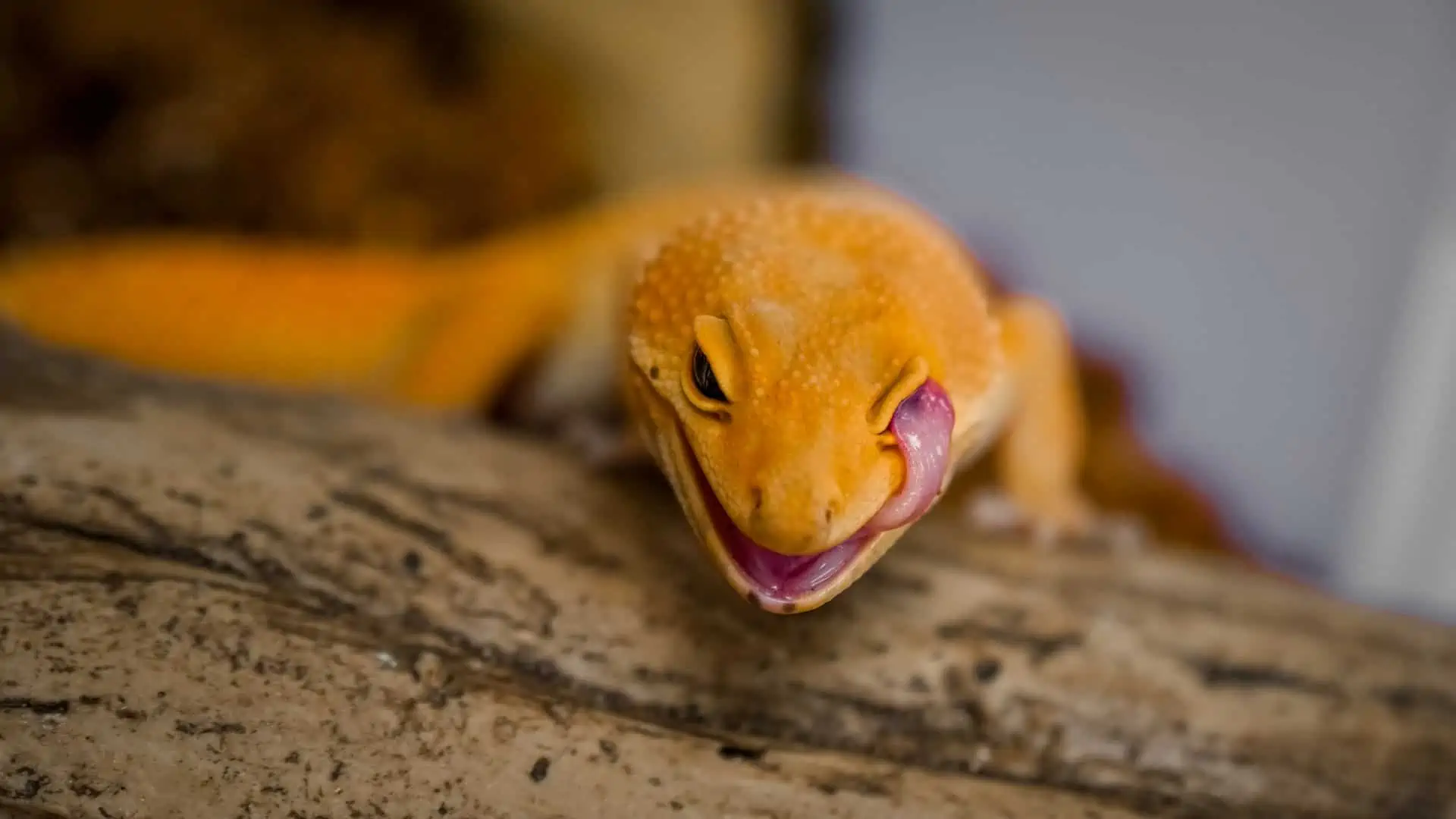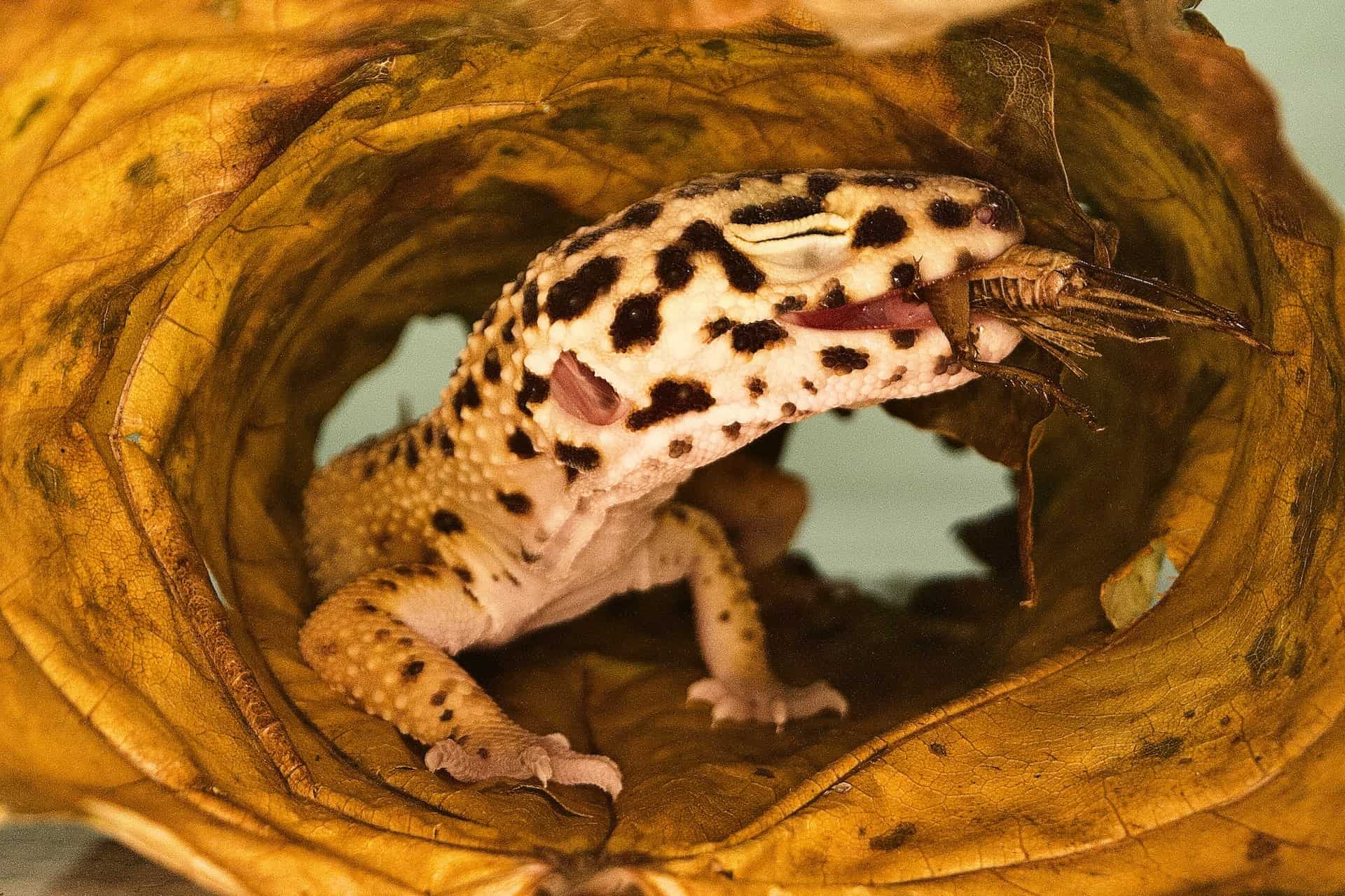For me, eye infections are the creepiest-looking of all the reptile alignments.
Something about that perfect, glassy eye on a pretty reptile face becoming swollen, cloudy, and covered with dead skin makes the ordeal almost unbearable to watch.
Still, turning your head away is the worst thing you can do. However shocking it may sound, some pet leos sadly get abandoned because of their illness. And it is in situations like these that they need us, their humans, the most.
Valid know-how is the key to saving a sick leopard gecko, so let me teach you a few fundamental things about eye infections.
In this article, I’ll cover the following:
- Reasons why eye conditions occur in leos
- How to recognize and identify an eye infection in a leopard gecko
- Treatment options for leopard gecko eye infections
If you’ve ever been wondering, “Why does my gecko have one eye closed” or “Why can’t my leopard gecko open his eyes,” you’ll find plenty of answers below.
Are Reptile Eye Infections Treatable?
Fortunately, despite the grim looks, eye infections in leopard geckos (and other reptiles) are highly treatable. Yet, it takes patience, TLC, and, often, professional veterinary care.
I’ve seen rescue cases with eyes that looked beyond saving, but still, the animals made a full recovery.
How do Leopard Geckos Get Their Eyes Infected?
Unlike many other species of geckos, leos have eyelids. The ability to close their eyes and blink makes their eyes less exposed to injury.
On the other hand, the eyelids increase the surface for potential infections and are tricky for skin shedding – so it is not a perfect “design.”
There are a few main ways your leo can get an eye infection.
The good news is that avoiding these issues, which is not super hard to do, automatically prevents eye problems in leos.
Physical Injury
The eye is a sensitive organ. Any physical injury can turn into an infection, even though geckos can clean the eyes with their tongues.
The potential for post-injury infection is higher if the hygiene of the tank is poor, temperature and humidity are inadequate, or the gecko is in poor general condition.
There are a few common instances in which captive leopard geckos can hurt their eyes.
Foreign Body in a Leopard Gecko’s Eye
When something gets stuck in our eyes, we tend to cry it out. Literally, our tears help push out any debris that bothers us.
Unfortunately, lizards can’t really shed tears. If something gets in their eye, leos will try to lick it off, sometimes with success. However, they may happen to need help.
Coarse debris (for example, from inadequate bedding – see below) can damage the lizard’s cornea and cause ulcerations, which is extremely painful for the unfortunate animal. Besides the pain, untreated ulcers can lead to complications that may lead to eye loss.
Constant eye licking and closed eyes (or one affected eye) are the most apparent signs that leo has something stuck there.
Injuries From Scratching and Rubbing
If a gecko has a stuck shed or another type of skin condition, such as mites, it will rub against objects in the tank. Frequent rubbing can lead to an eye injury, especially if the surface is sharp or rough.
Using the Wrong Bedding
Rough bedding – coarse sand and gravel, crushed walnut shells or tree bark, and wood shavings can hurt your leo’s eyes due to sharp or rough edges and high material mobility.
As said above, the debris can get stuck in your leos eyes and cause discomfort, pain, and dangerous ulcerations.
These substrates are not on the list of safe leopard gecko substrates anyhow – be sure to check the suitable bedding options for leo tanks.
Poor Hygiene and Inadequate Keeping Conditions
Inadequate hygiene, improper temperature or humidity, and poor diet can cause or add to existing eye issues.
For example, if a gecko gets injured, there is more chance it will lead to infection in a dirty tank. Stuck sheds happen more often in tanks that are too dry. A diet deficient in certain vitamins can cause multiple eye-related issues (see the Hypovitaminosis A section below).
Shedding Issues and Other Illnesses
Shedding issues in geckos rarely occur at random. Usually, there is a reason behind them. Read on to learn about the conditions that cause skin shedding to get stuck around the gecko’s eyes – pay special attention to Hypovitaminosis A and dysecdysis.
How Do I Know if My Leopard Gecko Has an Infection?
You’ll know that your leopard gecko has an eye infection by watching out for the symptoms.
Leos can’t tell us something hurts, so we have to analyze their behavior to ensure they’re all right.
The following behaviors are common eye infection red flags:
- Constant blinking
- Continued eye-licking
- Rubbing the head against rocks and other rough surfaces (this can also be related to other conditions)
- General lethargy, lack of appetite, excessive hiding (signaling that the leo is in pain)
Visual cues that your leopard gecko might have an eye problem are
- Closed eye or both eyes
- Discharge
- Shed stuck around eyes
- Visible debris in the eye
- Swollen eyelids
- Abscess
- Cloudy eyes
- Red eyes and eyelids
- A layer of dead skin over the eye
Behind these signs are well-defined eye conditions. Read on to find out what they are.
What is Wrong With My Leopard Geckos Eyes – Types of Eye Conditions In Leopard Geckos
For accurate and successful treatment, it is vital to recognize what kind of leopard gecko eye condition you’re dealing with exactly.
Even if you’re planning on visiting a specialized vet because of an obvious problem, it is useful to know what you can expect once you get to the vet.
Also, if you have been wondering how do you treat a leo eye infection, the “how to help” section offers tips on what you can do or a brief description of what to expect at the vet’s office and the follow-up treatment you will administer at home.
A piece of advice: Always choose a veterinarian specializing in reptiles or exotic animals. Many regular vets just don’t have sufficient experience with reptiles to handle eye infections infection correctly. That is why it is important to work with someone who knows what exactly they’re dealing with!
Here’s a list of common leopard gecko eye conditions, A-Z.
Abscesses
An abscess is an enclosed, below-skin infection, usually bacterial. It appears in the form of a relatively large, concentrated lump. The inside of the abscess is commonly filled with puss that contains bacteria and immune cells that fight them.
In leopard geckos, an abscess can appear as a secondary infection due to injury, in unsanitary conditions in the tank, or due to other health conditions.
How To Help: Abscess is definitely a vet job. Your reptile doc will open it with a needle or a scalpel, drain it, and clean it as much as possible. The follow-up therapy at home may include antibiotic eye drops or ointment, pain meds, and oral antibiotics for severe cases.
Blindness
Although it is not overly common, sometimes a leopard gecko will go blind. It can be a congenital anomaly, a result of very poor care and nutrition when the animal was young, head trauma, or another issue such as illness.
You will usually recognize blindness or poor eyesight by the leo’s inability to locate and properly catch prey on its own.
How to help: Although you can’t fix blindness, the good news is that a blind leopard gecko can still thrive. However, it will definitely need help with feeding. I recommend offering live prey with feeding tweezers. There is no need to adjust the tank.
Conjunctivitis (Pinkeye)
Unlike abscess, which is a consequence of a bacterial infection in the outer skin around the eye, conjunctivitis is a bacterial infection of the conjunctiva – the fleshy, pinkish tissue of the eye.
The signs of conjunctivitis are clouded eyes with discharge and puffy and swollen eyelids.
The infection mostly occurs in geckos in unkept tanks, especially if their water tray is also dirty. Soiled water is an ideal environment for bacterial proliferation, and it is a matter of time before the bacteria-laden water comes into contact with leo’s eyes. Also, lizards in generally poor health are susceptible.
How to help. The primary therapy for conjunctivitis in leos is antibiotic drops and ointments prescribed by a vet. Also, finding the cause of an illness is very important. Ensure the tank is clean, disinfect the water tray, dust the food with vitamins, and provide the correct terrarium temperature.
Dysecdysis (Shedding Issues)
Dysecdysis is not a single illness but rather an umbrella term for shedding problems that lead to dead skin buildup.
While it may sound like not such a big deal, these buildups can cause severe damage in sensitive areas, especially the toes and the eyes.
The layers of old skin stuck on the eye rims and eyelids harden and can damage eyes, push them into the eyesocket, and create a perfect breeding ground for infections. With time, they get harder and harder to remove.
Even when cured, dysecdysis around the eyes can cause permanent damage to the eyeballs or deform the surrounding tissue, leaving the affected leo with pockets below the eyelids and similar complications.
How to help. While you can give your leo a foot bath to help remove the dead skin “rings,” you should never submerge your leo’s head. Instead, special ointments are used before trying to remove the stuck shed layers with the right medical tools manually.
I would never recommend doing this yourself, as the eyes are highly touchy, and there is a big chance you may hurt your animal. Sheds stuck around the eyes are best handled by a professional.
Box: Be extra careful if you own an individual with a lightly-colored morph. Lingering old skin is much more difficult to notice in light yellow or white individuals than in normals or darker morphs. And indeed, I’ve seen most cases of eye dysecdysis in light morphs!
Hypovitaminosis A
You’ve probably heard that Vitamin A is essential for good eyesight.
The same is with leopard geckos – and the chances are that in captive conditions, they can’t get enough of it from a limited choice of insects (insects are not very rich in Vitamin A anyway).
Hypovitaminosis A is a pathological Vitamin A deficiency. It has several manifestations: eye issues, problems with skin and shedding (Dysecdysis), infertility, and general lethargy.
Hypovitaminosis A-caused eye issues include:
- Eyelid swelling (usually severe – the leo may not be able to open its eyes)
- Stuck shed (dysecdysis) around the eyes
- Conjunctivitis
So, a problem with the eyes, combined with skin issues and other problems, definitely signals hypovitaminosis. A leo with this condition may look like it’s literally falling apart.
Luckily, the disorder is treatable.
How to help: Prevention is the best cure for Hypovitaminosis A. Gut-loading insects with Vitamin A-rich food and multivitamin dusting is essential to ensure the proper intake of Vitamin A in captive reptiles. Take these routines seriously.
If hypovitaminosis A has already taken hold, the gecko should be fed a proper diet rich in the deficient nutrient while getting treated for symptoms and secondary issues caused by hypovitaminosis. In severe cases, a reptile vet may administer an injection of Vitamin A.
Box: Providing geckos with pure vitamin A supplementation is a bit controversial. Some sources recommend dusting the food with Vitamin A powder only every 12-14 days, and I agree it’s a good strategy for lizards already at risk of hypovitaminosis. However, it is not necessary (and is slightly risky) for healthy geckos who have a varied diet and quality multivitamins available. All multivitamins from reliable manufacturers contain sufficient amounts of Vitamin A.
Parasites
Leopard geckos can keep their eyes closed due to discomfort caused by parasitic infections. If your leo keeps its eyes closed, plus is thin, has a poor appetite, and has a runny stool, it’s time to test for parasites.
However, some sources claim to witness actual parasitic eye infections – with “thin, string-type worms in the conjunctival sac of the eyes in pet leopard geckos.”
How to help: While it’s a rare occurrence, take your leo to a vet ASAP if you notice this oddity. There are regular parasite treatments for reptiles, usually given orally.
Proptosis
Brace yourself – this one is a bit gruesome. Proptosis stands for an eye popping out of the socket. The only way for this to happen is a heavy-duty accident – an aggressive squeeze or a fall, for example.
How to help: Since there is usually no way to return the eye to its socket, the vet will surgically remove the eye that has popped. A leo can survive without an eye, although it may need some assistance when feeding (see: blindness).
Ulcers
A corneal ulcer is a laceration on the cornea, a thin transparent membrane that covers and protects the iris and the pupil.
How to help: Since the cornea is transparent, an ulcer is hard to see. Reptile vets use special eye stains and fluorescent dyes that reveal the ulcer when lit with a UV lamp – but you can’t do this at home. Also, there is no home remedy for these ulcers, so the vet’s office is your only option.
Treatment for corneal ulcers consists of eye drops that you will administer at home (the vet will show you how to do it – if they don’t, make sure to ask), followed by a check-up in a few weeks. Note that eye ulcers are slow to heal, so be patient.
Take Care!
I hope this article has shed some light on leopard gecko eye health for you.
As you see, every leopard gecko eye infection is a concerning but treatable matter. Having an experienced reptile or exotics vet to help you out is the best option for most eye conditions.
Eye infections in leos can occur for various reasons – but there always is a reason. One of the most important things is to trace it down and ensure it doesn’t repeat. Prevention is definitely the best cure for leopard gecko eye infections – and it is not hard to do.
Have you had an experience with eye infections in leopard geckos? Feel free to share it in the comments as it could be extremely valuable to others. Also, if you found the article useful – spread the word!




